Arts & Entertainment
Gays prominent at Amy Grant’s Nashville weekend
Gathering reminds how much is missing of singer’s touring history

Weekend before last, a friend and I made a road trip to Nashville to spend a weekend with Amy Grant and 550 of her nearest and dearest. It was a great weekend — $50,000 was raised for various charities Grant supports, the music performed (almost all requests) was a long-time fan’s dream come true and the Gospel Music Hall of Famer and six-time Grammy winner was as accessible and approachable as was realistically possible considering those attending were among the all-time die hards, a few of whom had vulture-like tendencies everytime Grant appeared.
That gays — and at least one lesbian couple and one trans woman — were among the group was hardly surprising. We’ve been among the most vocal in her fan circles for years. Most non-church folks remember Grant only for a few early ’90s hits (“Baby Baby,” “Every Heartbeat”). Though her catalog has aged well, she’s not deemed terribly high on the hip quotient. Even one of the charity recipients said, “Amy Grant — isn’t she Vince Gill’s wife?”
But for a generation of gay men who grew up in Baptist and Evangelical churches in the ’80s, Grant was so much more than that and, no exaggeration, a lifeline. Contemporary Christian Music had its own parallel universe divas — Sandi Patty, Twila Paris, Margaret Becker, et. al. — and Grant, who in many ways had and maintains a very non-diva-esque persona, was queen of the lot. But that’s just one of the ironies of Grant’s career — she also stumbled into the music biz without really trying, has always been upfront about her modest pipes (she’s really a better songwriter than singer) and, despite a bounty of RIAA Platinum albums, never fully fit in in either the gospel or pop establishments.
Those of us in fan circles have discussed ad nauseum Grant’s public handling of her gay fans (or lack thereof). She’s warm, friendly, gamely poses for photos with male couples, etc., but is careful never to state her personal feelings one way or the other. One understands to a degree — she’s in a no-win situation. As was obvious from the attendees last weekend, most of Grant’s fans are Gen. X and post-Boomer soccer moms from the Bible belt. We all seem to mix pretty well. I hope they feel the same. But Grant would alienate a large part of her fan base if she were to come out one way or the other on her feelings of the Bible and homosexuality. There’s a clamoring among gay fans, of course, for her to be more unequivocal. Nobody’s expecting Lady Gaga-caliber activism, but heck, even the late Tammy Faye Bakker Messner was more openly gay accepting than Grant. Perhaps, though, having lost everything already, Tammy Faye had nothing left to lose (Tammy Faye even joined us at Capital Pride about 10 years ago …. Ahhhh, Tammy Faye, how I miss thee).
Grant does occasionally take risks — it will undoubtedly seem like a non-issue to many, but monogrammed bottles of Jack Daniels with Amy Grant nameplates were sold for $100 a pop at her farm, which she opened to guests on June 23. It all went to charity but the irony was delicious — I’m old enough to recall the outraged reactions in the ’80s when Grant said in an early interview that she occasionally imbibed. Folks at my parents’ church were apoplectic.
It’s never been a big deal to me, either the booze or the gay stuff. Some fans, so eager to glean the slightest glimmer of acceptance (are we really that desperate for validation?), latched on to an off-the-cuff remark she made during the weekend when a guest southern gospel singer, telling a story about a drag queen who’d parodied his wife, said his group had a large gay following (Grant acknowledged she did as well).
The draws for me have always been Grant’s music and personality. There’s a freshness, a buoyancy, to her music that, though it sounds stylistically dated, never really goes away. It goes back to the first album — lyrics and energetic Brown Bannister production around lines like, “The sun woke me up real early it’s a beautiful morn/so I’m goin’ down to the river to be reborn” still resonate 35 years after they were put down on wax. My parents, both products of stodgy, old school mainline and Roman Catholic versions of Christianity, had early-’70s born again experiences and for them and their fellow Boomers, there was a parallel Jesus music/born again fever sweeping the country the same time Stonewall and the modern gay rights movement was kicking off. This is no coincidence — hippie ideals weren’t sustainable, of course, but what they did bring us was a shucking off of the ’50s mindset on all kinds of issues. In terms of gay stuff, faith, and a whole lot more, this was not your parents’ (my grandparents’) America. Grant got in on sort of the tail end of that but shot off into the stratosphere in the early ’80s. By then, things had calmed down and she became the voice of a churchgoing, Bible Belt generation with songs like “El Shaddai,” “Sing Your Praise to the Lord” and “Thy Word.”
Bored eventually with straight-up gospel, she gradually started flirting with pop music and following a hit No. 1 duet with Peter Cetera in ’87 (“Next Time I Fall”), she had a full-on hit pop album of her own by 1991 (“Heart in Motion”). But she never fully went one way or the other. At the point in which an all-out pop album would have made the most sense — just following the Cetera hit — she went the other direction and made an impressionistic gospel album, “Lead Me On.” Its singles tanked on pop radio but it went onto become her critical peak and has been called (by CCM magazine, et. al.) the best gospel album of all time. Likewise, when “Heart in Motion” was going through the roof a few years later, Grant was careful to let people know she hadn’t sold out as she was so often accused of doing by the hardliners (she gets bonus points, in my opinion, for having been condemned by Jimmy Swaggart). The album closes with the all-out praise song “Hope Set High” (“if there’s anything good that happens in life, it’s from Jesus”), a song she memorably performed last weekend.
So were the young gays of the era, hopelessly stranded in the Bible Belt with no hope of escape until college, just latching on to the closest thing we could get to a lighthouse in Grant? Not really — it’s deeper than that. I and many I know were also listening to Madonna, Janet Jackson, Cyndi Lauper and Tina Turner (we all figured “Private Dancer” was her first album) back then too, even if we had to sneak their tapes into the house. It’s hard to know if Grant meant any of this intentionally or if it was her own way of sneaking in some stuff past the gatekeepers, but there are glimmers of gay hope dotted all throughout her discography from as early as 1980 when she sang the lyrics her then-husband, Gary Chapman, had written (“all I ever have to be is what you made me/any more or less would be a step out of your plan”) to her own lyrics just a year later (“being this person inside of me/unafraid of being me/no more faces to hide behind …/even if I am the only one who wants to fly”) and even much later, with the 2003 song “Out in the Open” (“there is no jury, there is no judge/ready and waiting are the steady arms of love”). If it all sounds vague or like searching for something that’s not there, keep in mind, more often than not, Grant was nearly as subtle with her Christian references. It seems laughable now, but people used to parse her lyric sheets and balk at how few references there were to Jesus and/or God anytime she had a new album out, noting how increasingly infrequent they were becoming.
I don’t particularly care what Grant’s personal views are on homosexuality. Sure, it would be great if she would at least take the Dolly Parton approach to embracing/acknowledging us. Lord knows we need all the help we can get on the LGBT rights front where each step ahead feels like pulling teeth. But conversely, what does it say about us as fans if we need some sort of acknowledgement from our favorite singers? I do get it — when you’ve invested emotionally and financially in a singer/brand who’s meant so much to you, especially during the raw, painful formative years (and let me tell you, it’s lonely being the only gay fish in an evangelical, Bible Belt pond when you’re 13), it means a lot to know those you admire are on board. But as adults, ultimately that need for validation says more about our own desperation than anything it might suggest about Grant. For the record, Sandi Patty, perhaps my other all-time favorite singer, is just as evasive. There are quietly gay people in her camp and she once told a group of gay fans who hosted a tribute post-show event for her in New York that she was “feeling the love,” but she, too, stops short of any condoning type-of statement. They’ll both talk to any small-town newspaper in which they happen to have an upcoming show, yet my Blade interview requests go curiously unacknowledged. Perhaps they feel they’ve already rocked their Christian fan bases enough having spent the last 10-15 years rebuilding after each going through controversial divorces (Sandi’s first husband, John Helvering, and Amy’s, Gary Chapman, were huge parts of their touring entourages in the ’80s; John ran sound for Sandi; Gary was Amy’s band director on several of her biggest tours).
My ultimate frustration with loving these singers falls into a whole other category entirely — to my endless chagrin, whole chapters of their touring history are missing in action. Sure, I love mainstream pop and rock too, but if you’re a Stevie Nicks fan or, merciful heavens, a Tori Amos fan, and you’re willing to look in some, ahem, unofficial places, you can find audio circulating of practically every show they’ve ever done. Same with the Stones, Bob Dylan, Springsteen — all the big dogs you’d expect. Other acts, like Pearl Jam, have recognized the insatiable appetites of their staunchest legions, and have released “official” bootlegs, manna from heaven for those who’ve worn out the studio recordings and spent many hard-earned dollars following them around. Even Cyndi Lauper, who traditionally has varied up her live show way more than, say Madonna or Janet, has a surprisingly rich bevy of fan-generated recordings out there. Different artists have different feelings on this sort of thing (the Grateful Dead famously encouraged it), but the sticking point for many is that it’s OK as long as you don’t attempt to profit off it.
Amy and Sandi both fall into that category — Sandi didn’t even bat an eye when people plunked down camcorders on mini-tripods at a Nashville event she hosted last year — and yet huge swaths of their concert-giving history are unaccounted for. And I’m not talking about obscure stuff, either — tours like Amy’s “Heart in Motion Tour” and Sandi’s “Another Time Another Place Tour” were mammoth operations playing arenas for months on end all around the country 20 years ago. On one hand, it’s not terribly shocking — these are not singers, historically, with wildly inventive bands who shook up their set lists drastically from night to night. However, when 25 years has gone by and you can’t even find a complete set list and no official live album or VHS concert tape was ever released, this brings its own level of frustration. These people have spent half their lives on the road, yet there’s precious little evidence that they’ve even left their living rooms.
Just for the record, my holy grails in this vein are — Sandi: anything pre-’83, the ’84-’85 “From the Heart Tour” (her first cross-country jaunt), the ’91-’92 “Another Time Another Place Tour” or the ’98 “Artist of My Soul”-era dates. For Amy: always wondered how complete the “Age to Age” concert video is — at 90 minutes including Gary’s set, one imagines a few numbers might have ended up on the cutting room floor. Only a handful of individual numbers have ever surfaced from the 18-month-long “Unguarded Tour” — surely somebody taped this at least one night (soundboard tapes were reportedly made each night but have never surfaced in fan circles). Also curiously missing from trading circles is her biggest tour ever — the “Heart in Motion Tour.” Audio has been known to exist, but nobody I’ve ever talked to claims to have it. I’m totally down for a no-profit swap if anybody has any of this stuff.
If there’s an upside to all this, it’s that Amy and Sandi are still out there and active. Patty records regularly and has released an album almost every year of the last decade. Grant only records here and there (she’s reportedly working on a new album), but she tours almost constantly. It’s a blessing I don’t take for granted as a few of my other favorites from the era — Paris and Becker — have, with precious few exceptions, completely stopped recording and touring.
Time to move on and get a life? Yeah, probably, but isn’t it uncanny how deep the nerve is that takes you back to the first music you ever discovered on your own? For me, it defies explanation. And so the quest/obsession continues. I’m even — don’t laugh — planning to check out a D.C. Women of Faith conference in August. Ordinarily I’d rather sit home and watch paint dry (I’ve left much of that theology long behind), but — holy of holies — Amy and Sandi are BOTH scheduled to be there!

Team DC, the umbrella organization for LGBTQ-friendly sports teams and leagues in the D.C. area, held its annual Night of Champions Awards Gala on Saturday, April 20 at the Hilton National Mall. The organization gave out scholarships to area LGBTQ student athletes as well as awards to the Different Drummers, Kelly Laczko of Duplex Diner, Stacy Smith of the Edmund Burke School, Bryan Frank of Triout, JC Adams of DCG Basketball and the DC Gay Flag Football League.
(Washington Blade photos by Michael Key)

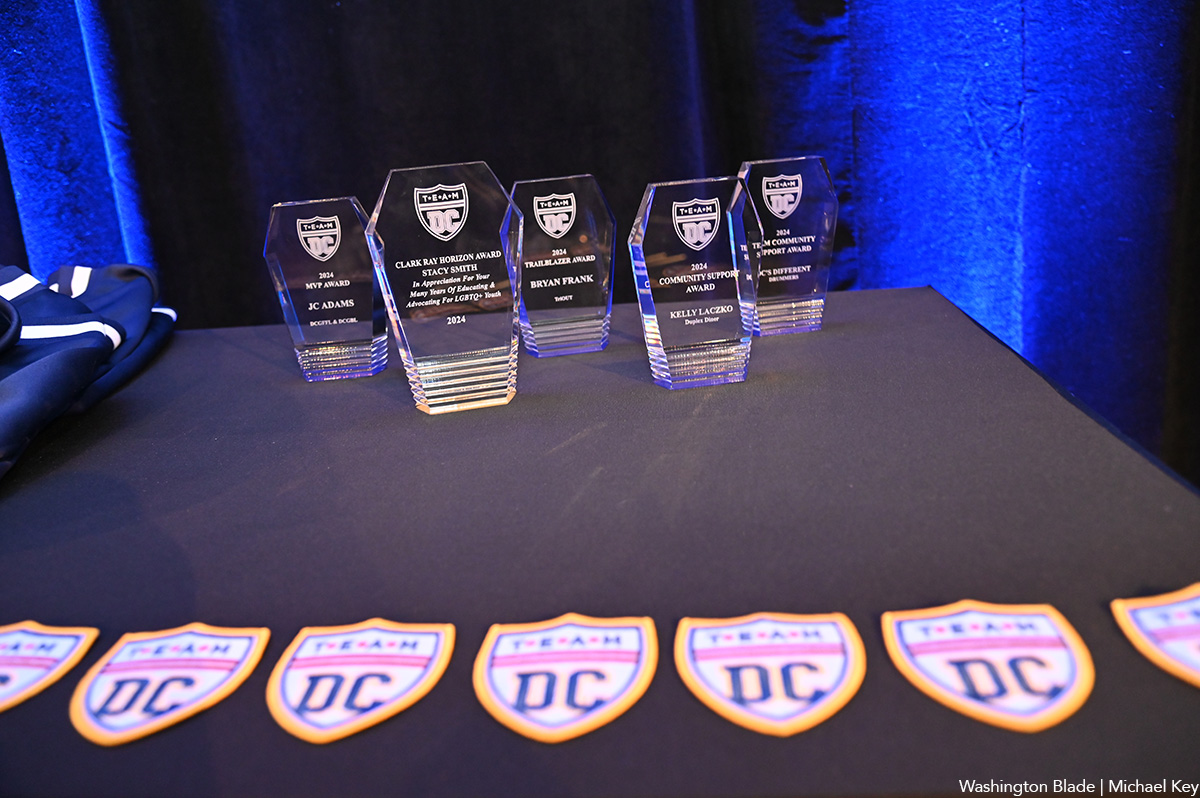
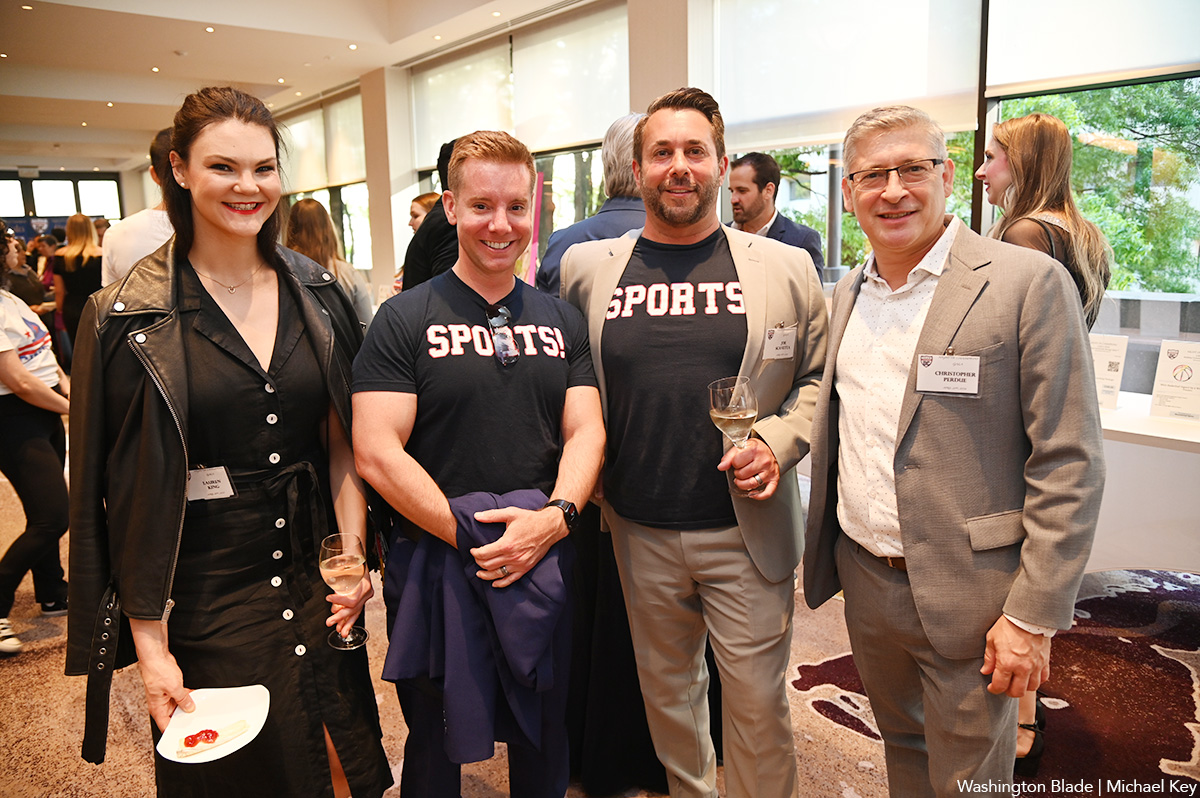
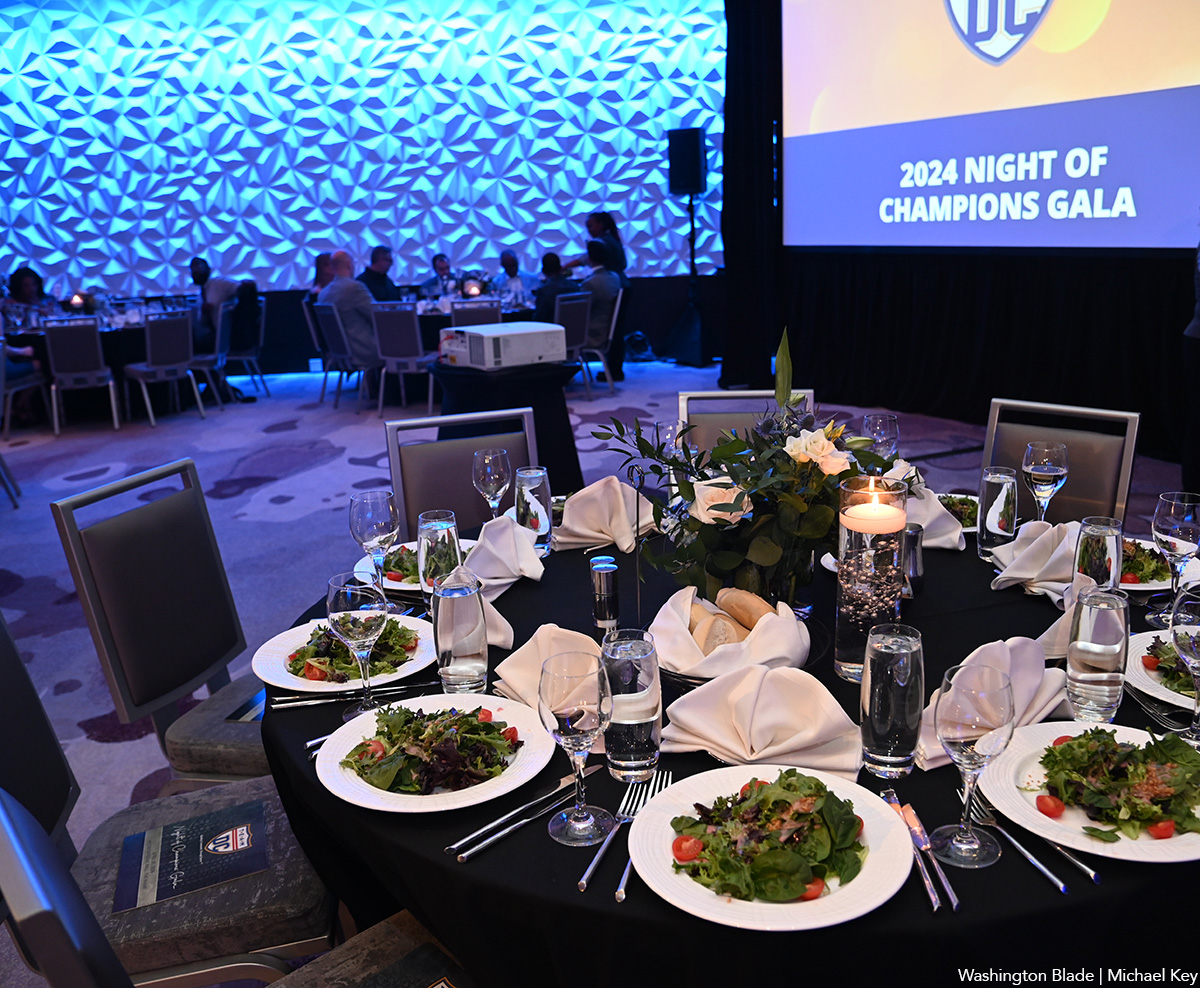


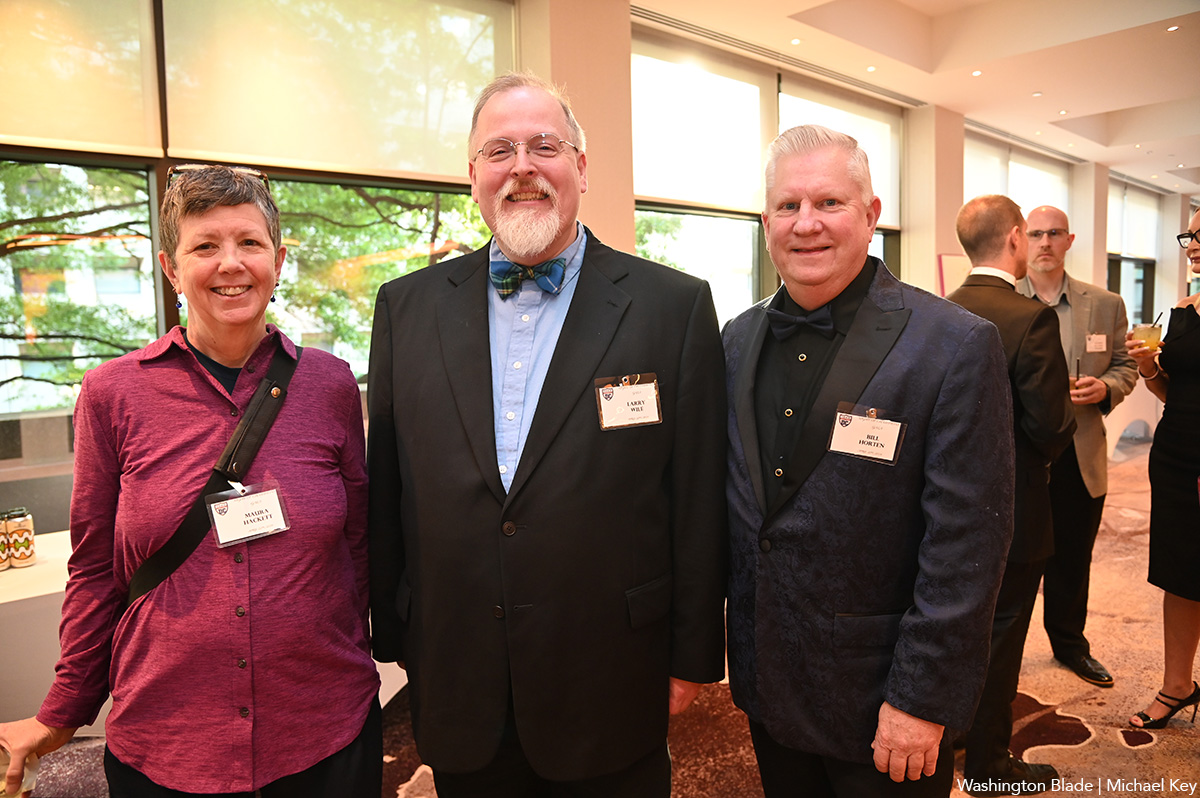
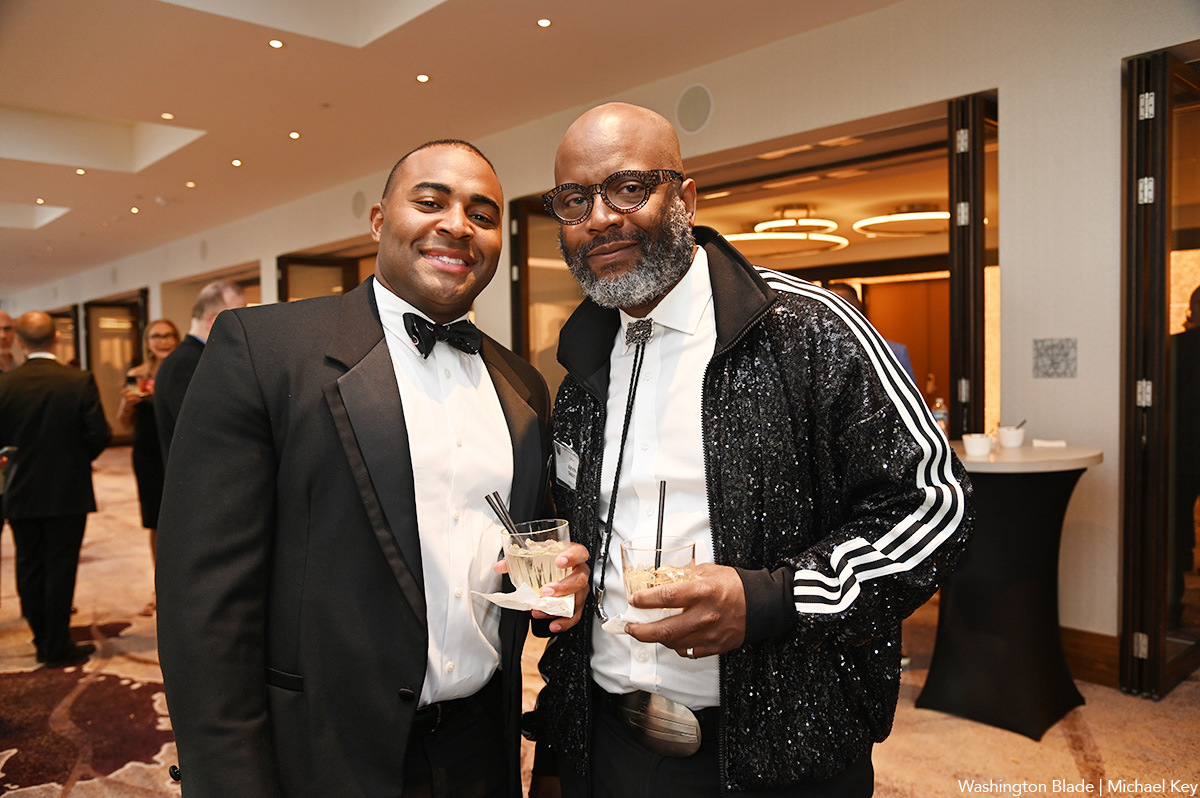
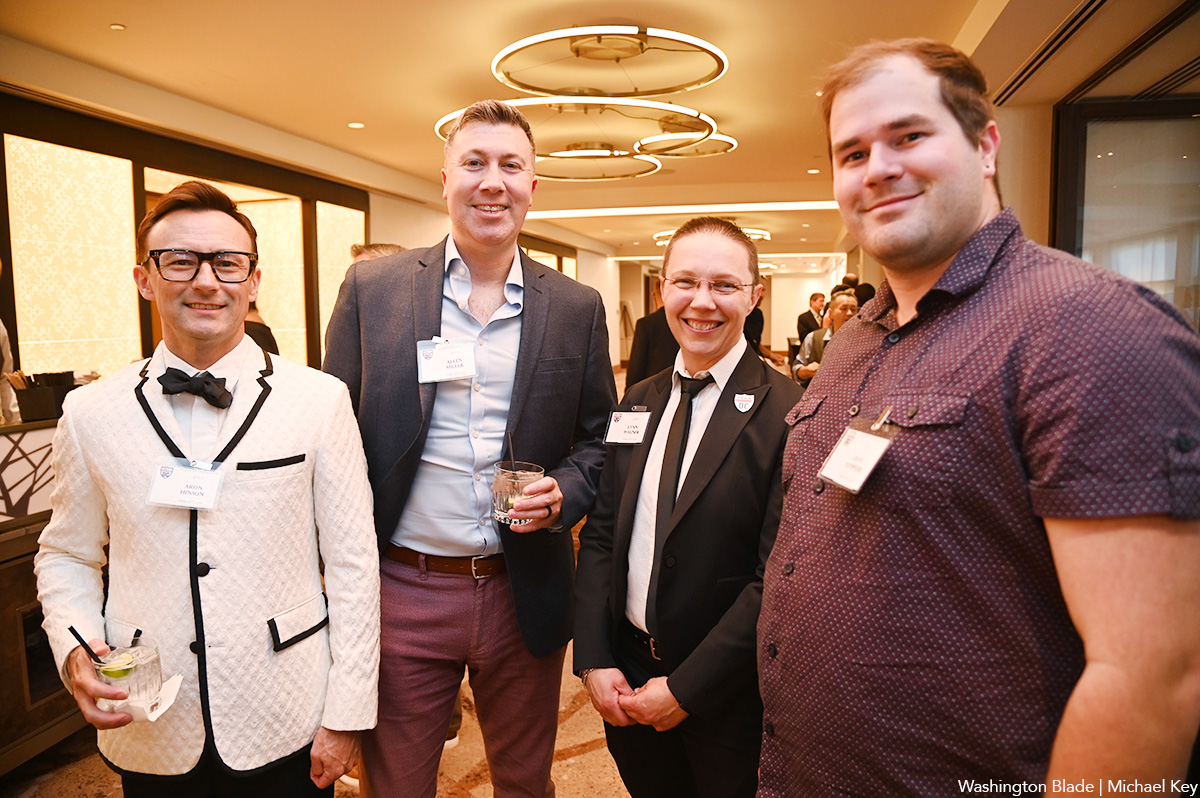
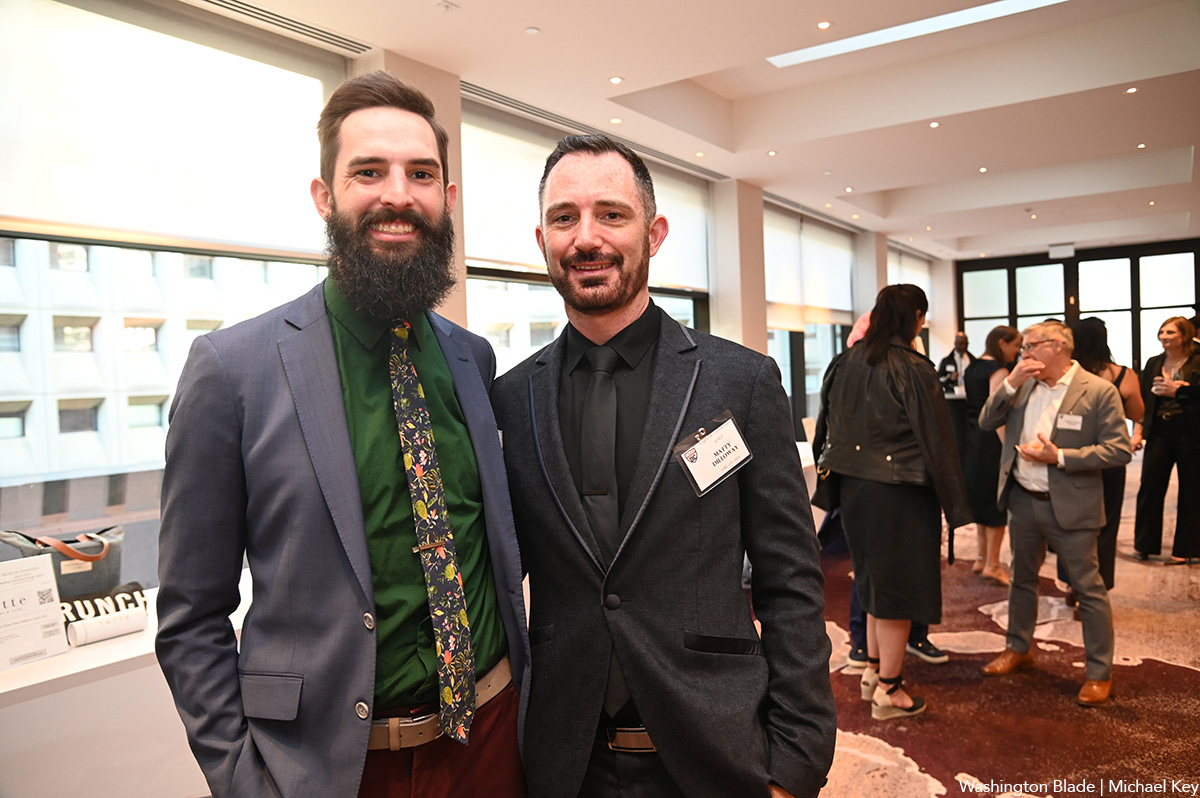

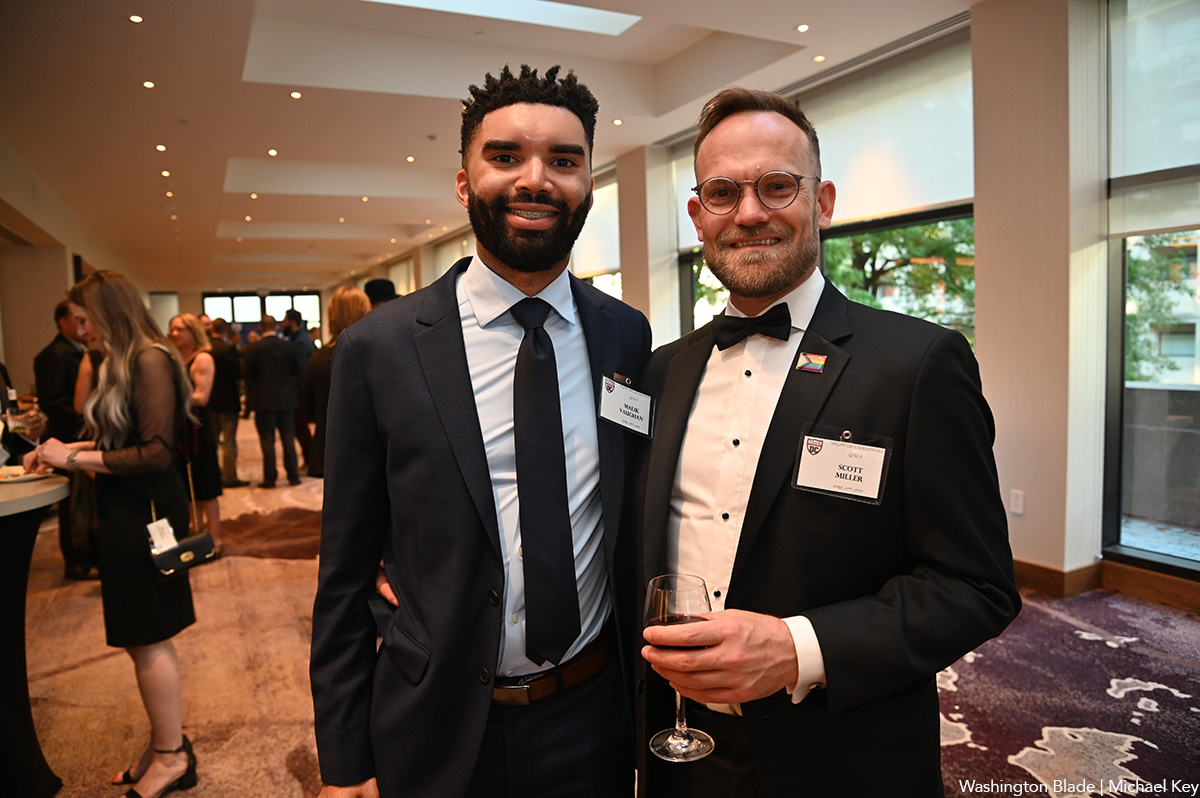

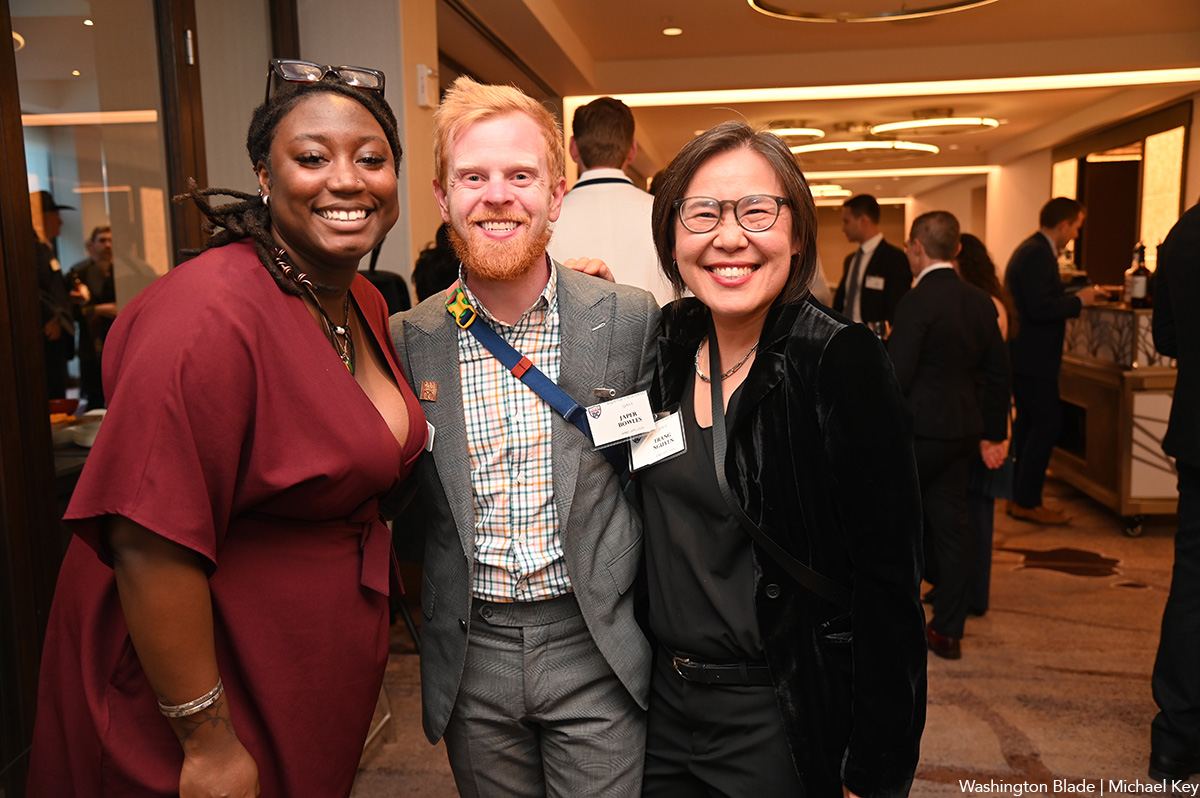
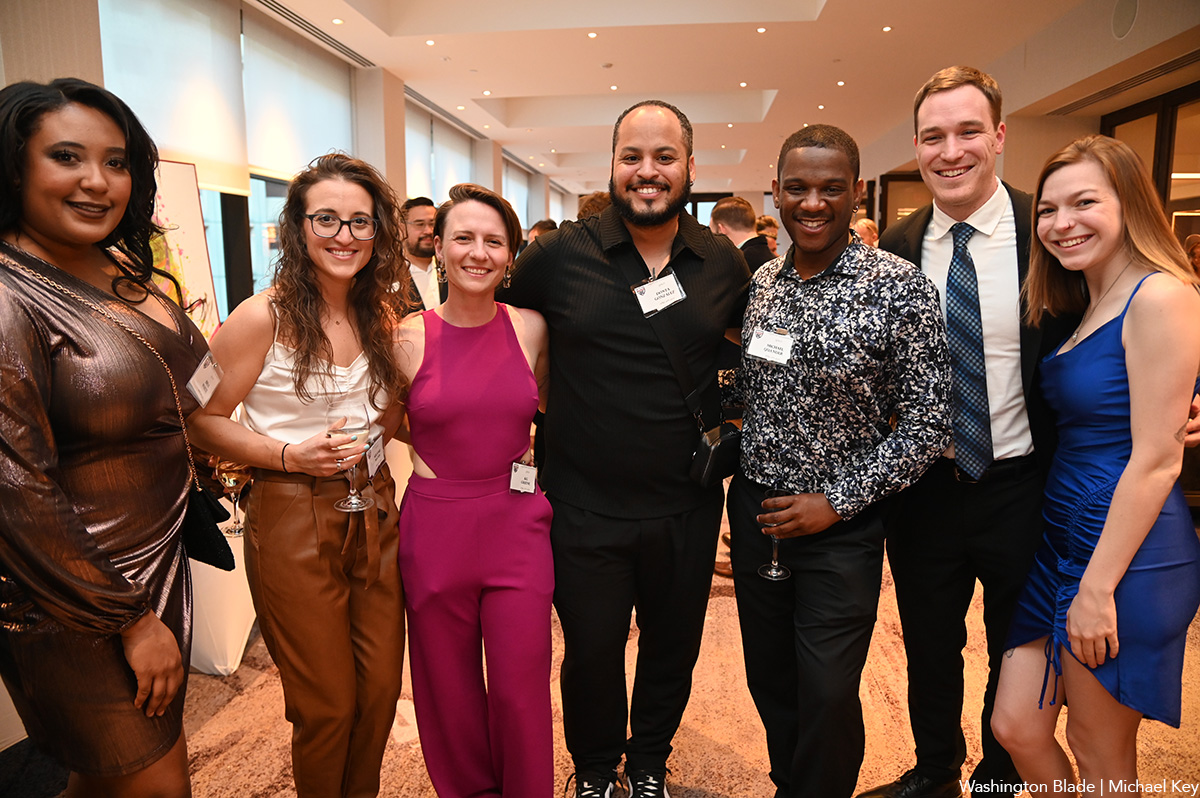
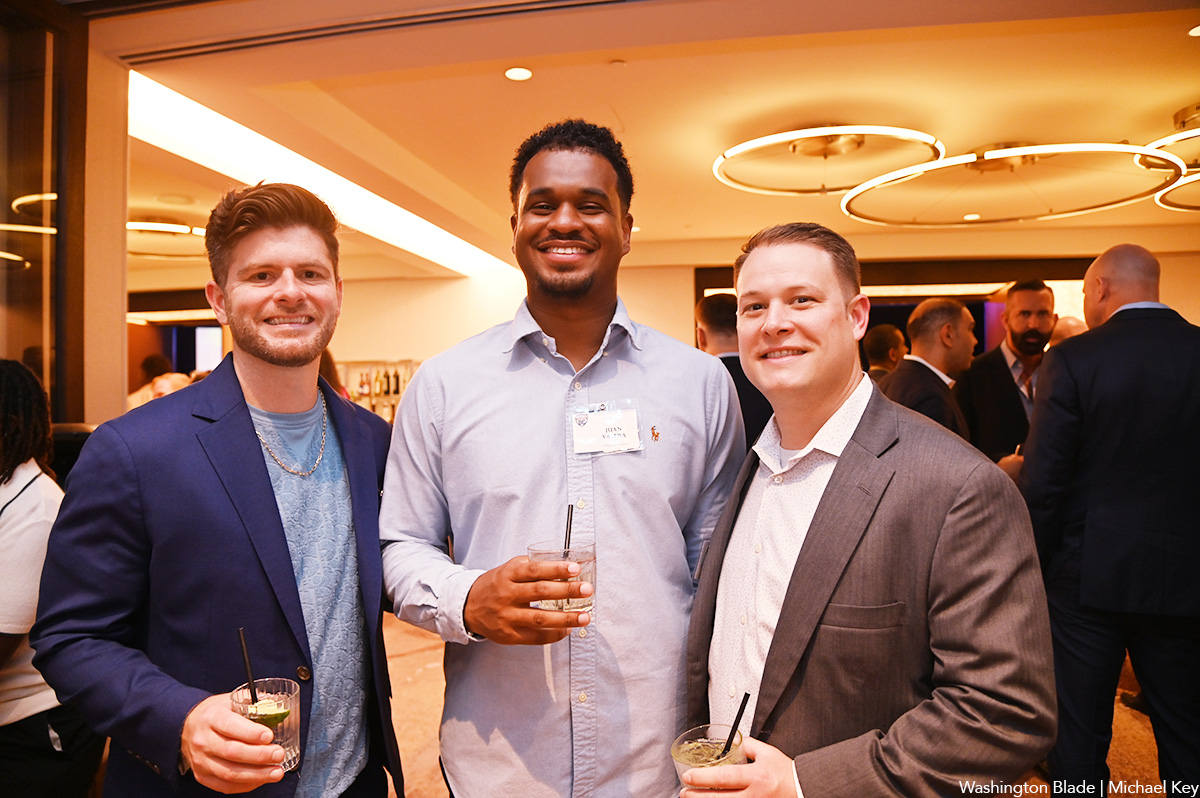
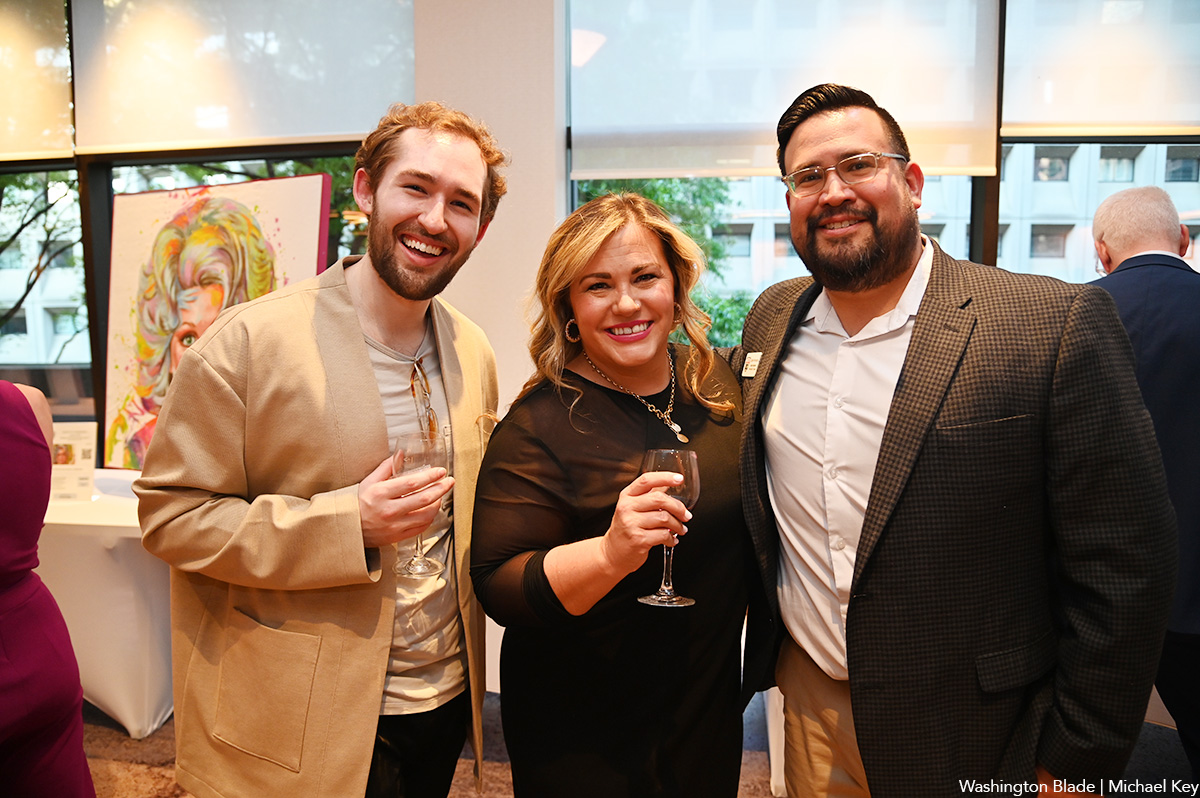
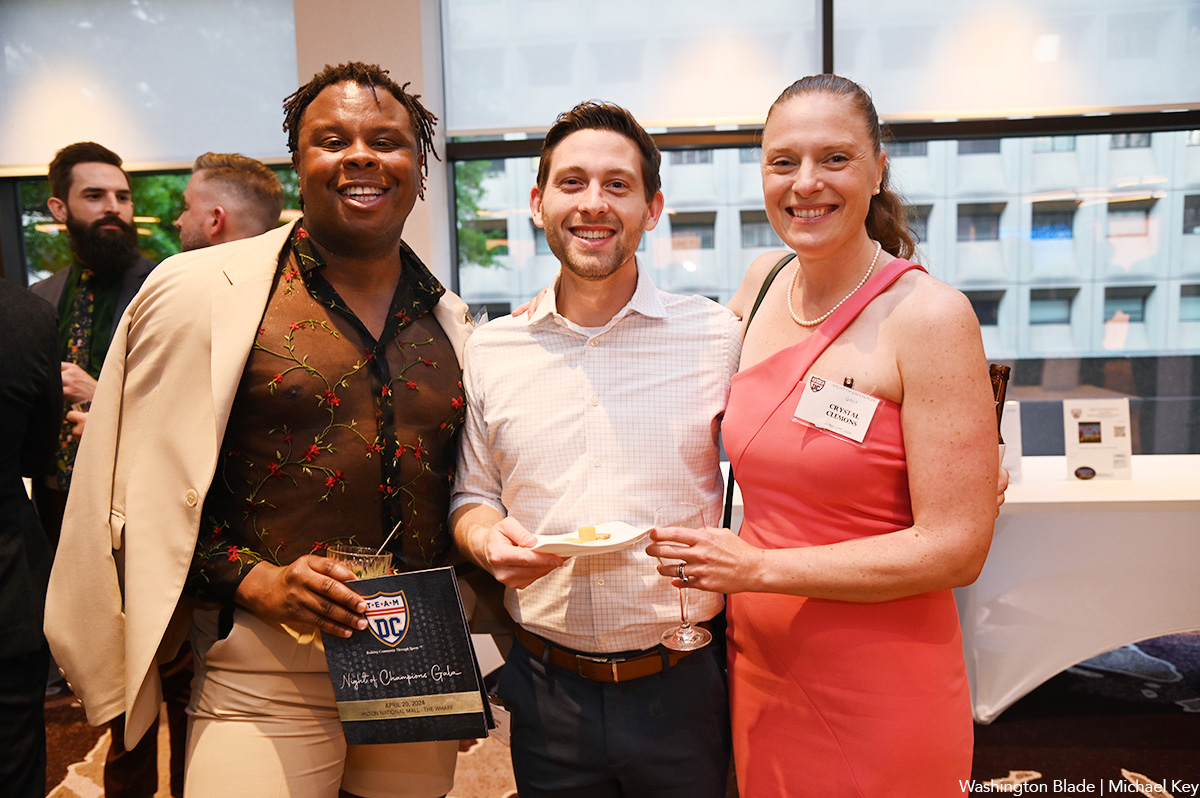
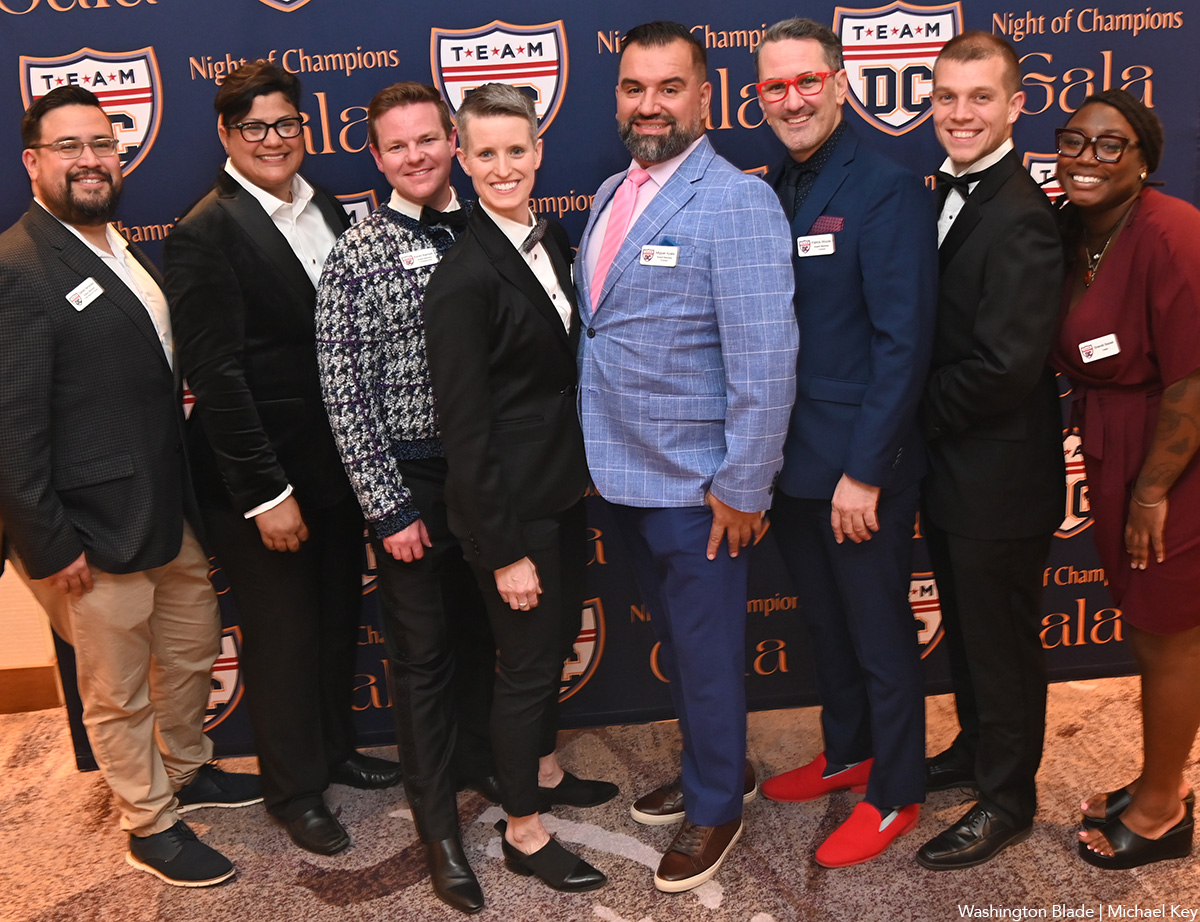

The 2024 National Cannabis Festival was held at the Fields at RFK Stadium on April 19-20.
(Washington Blade photos by Michael Key)
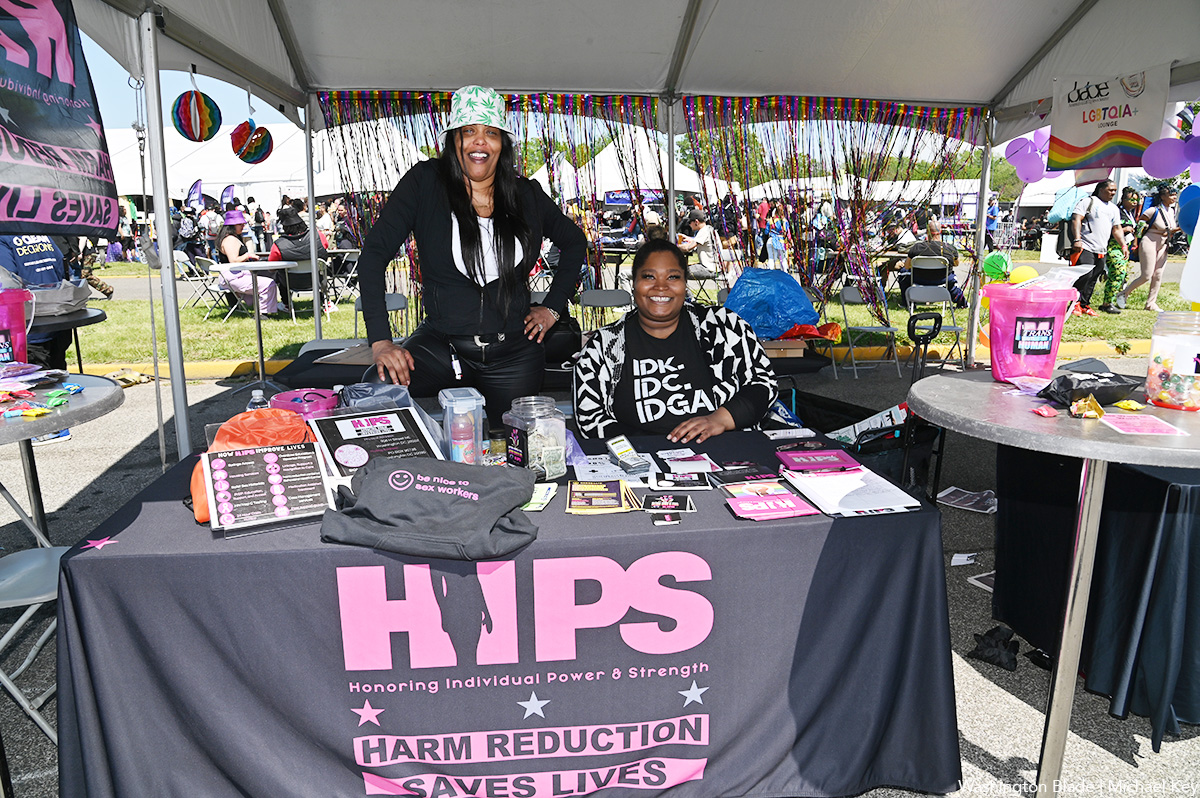





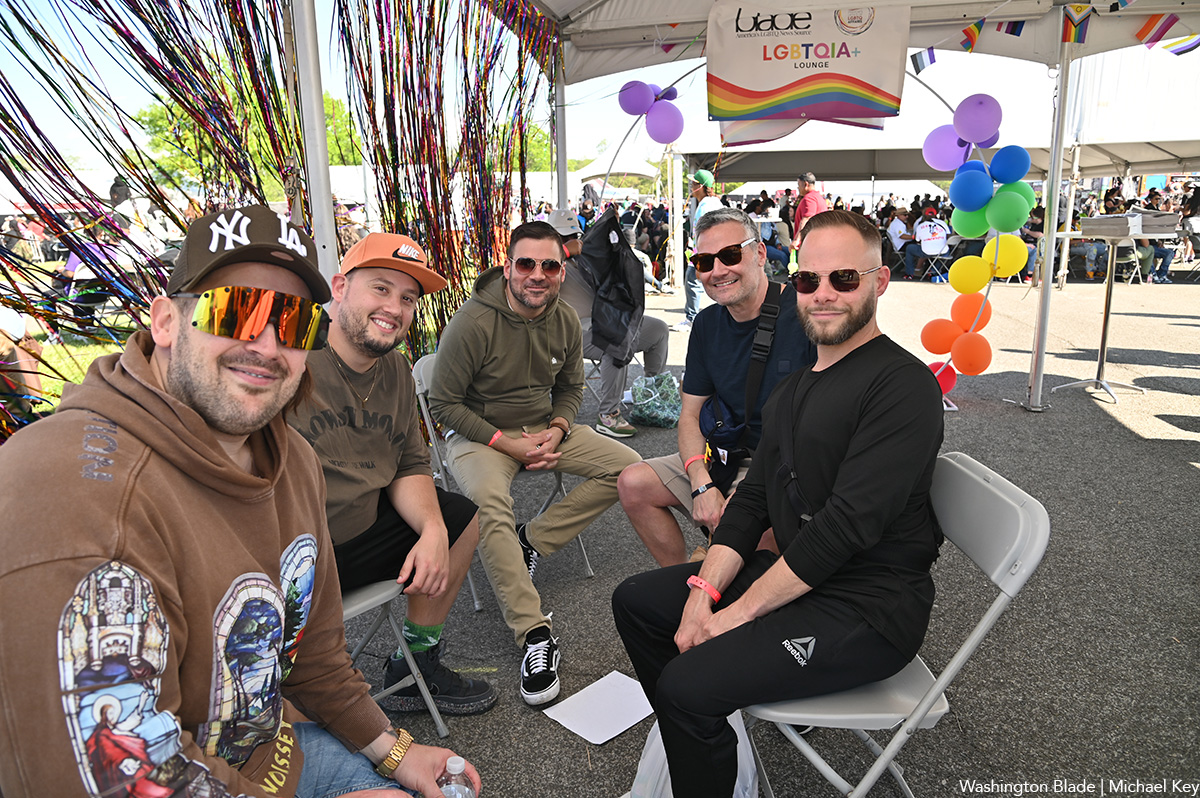
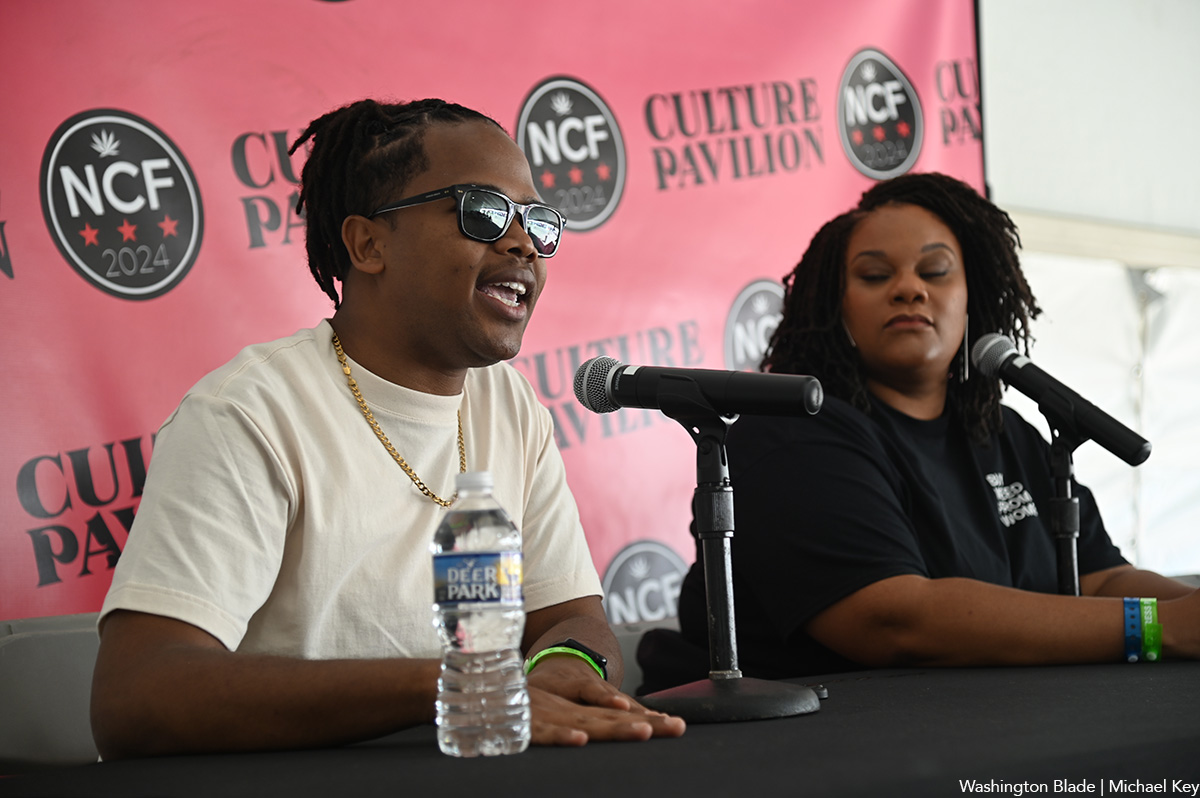
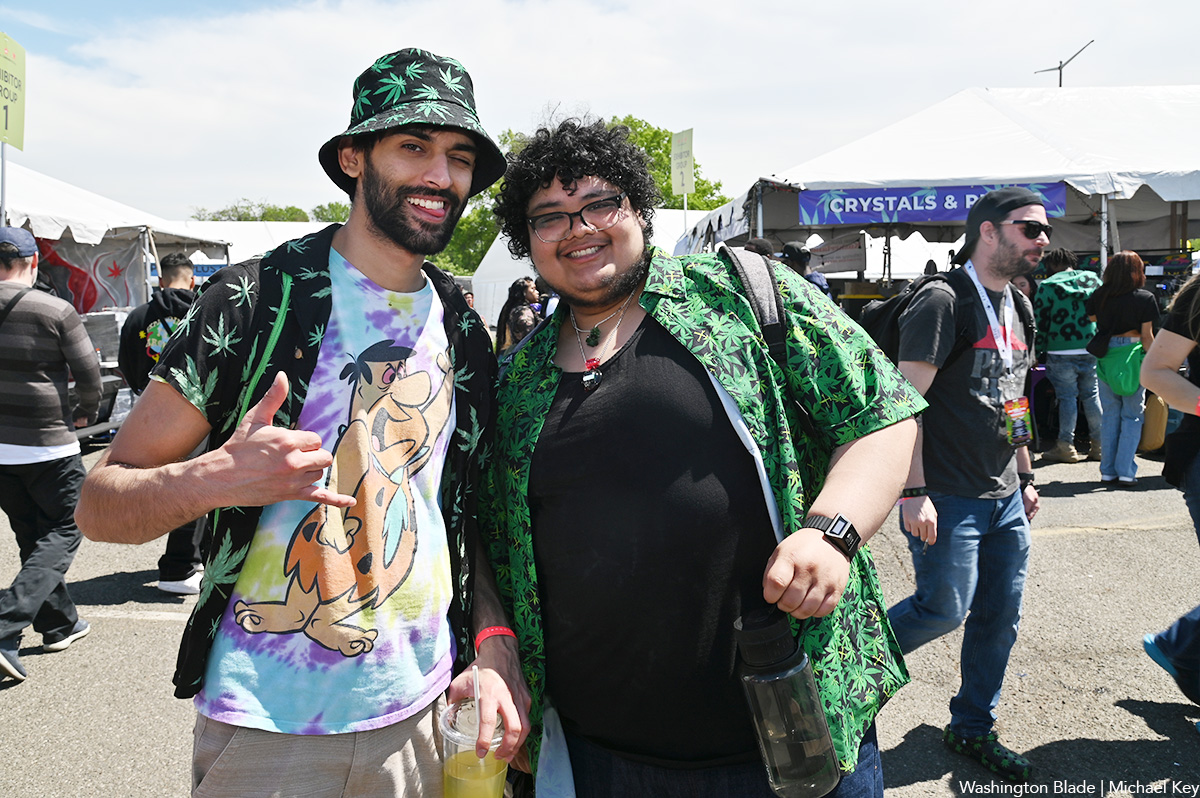



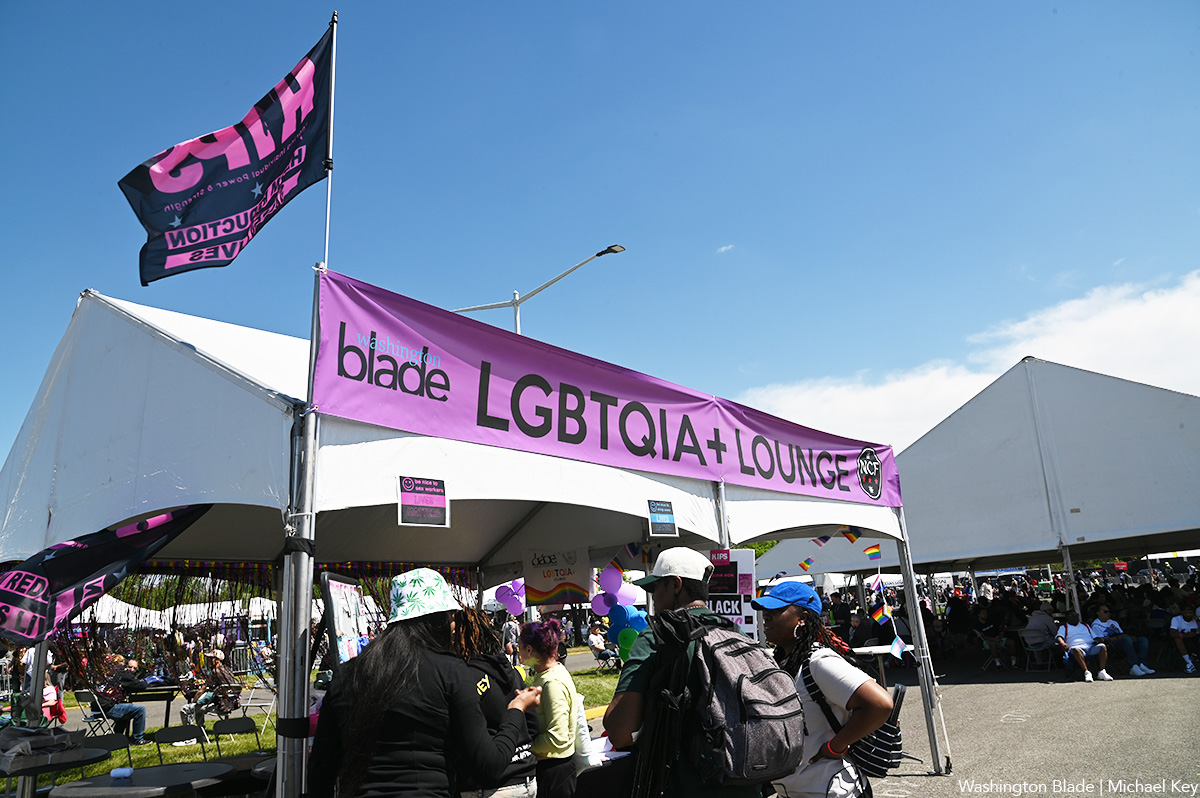
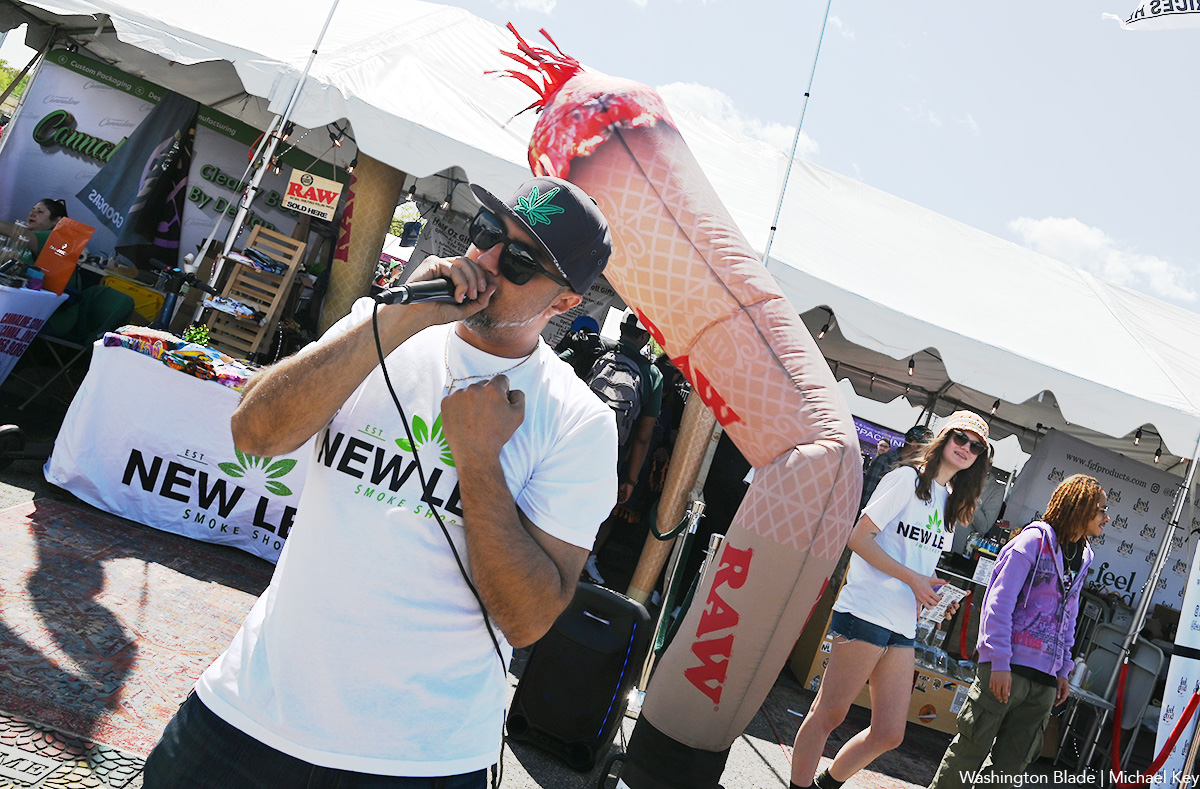
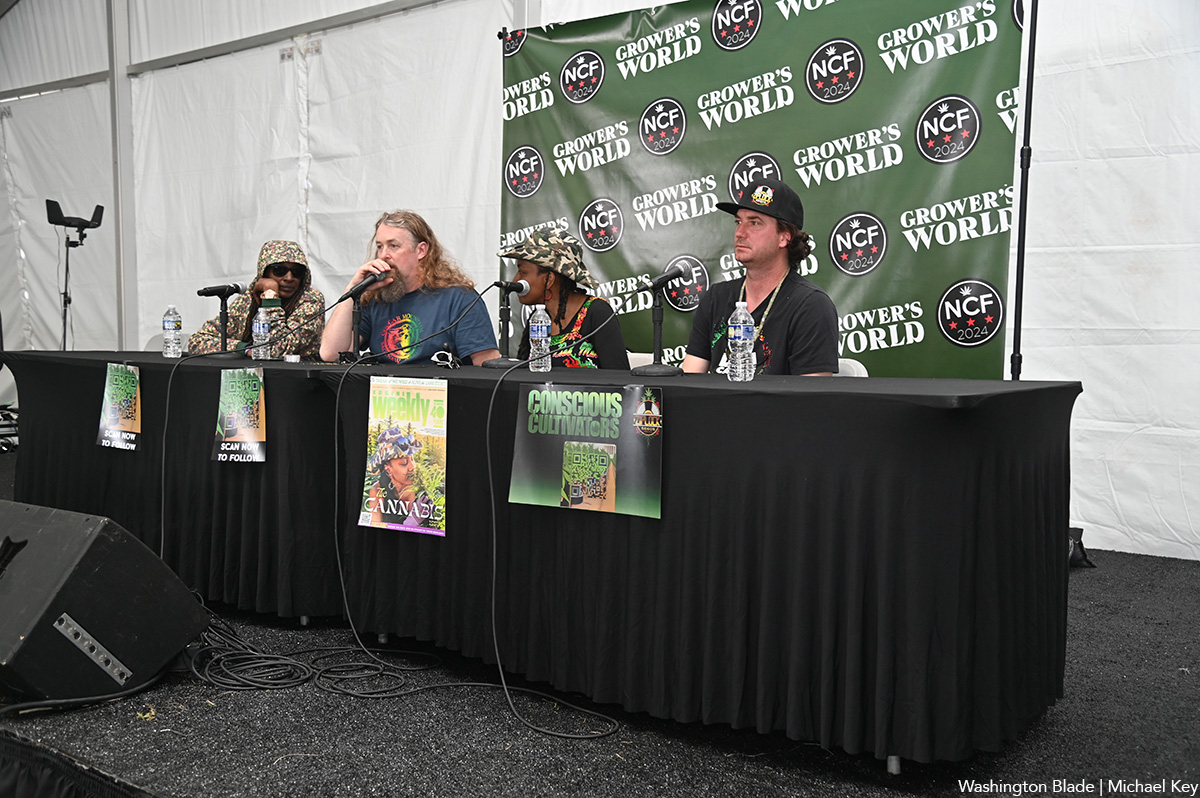

Covering the @NatlCannaFest at RFK Stadium for @WashBlade . Stop by the LGBTQ+ booth and pick up a paper if you are here. pic.twitter.com/is7hnsaPns
— Michael Patrick Key (@MichaelKeyWB) April 20, 2024
Theater
‘Amm(i)gone’ explores family, queerness, and faith
A ‘fully autobiographical’ work from out artist Adil Mansoor

‘Amm(i)gone’
Thorough May 12
Woolly Mammoth Theatre
641 D St., N.W.
$60-$70
Woollymammoth.net
“Fully and utterly autobiographical.” That’s how Adil Mansoor describes “Amm(i)gone,” his one-man work currently playing at Woolly Mammoth Theatre.
Both created and performed by out artist Mansoor, it’s his story about inviting his Pakistani mother to translate Sophocles’s Greek tragedy “Antigone” into Urdu. Throughout the journey, there’s an exploration of family, queerness, and faith,as well as references to teachings from the Quran, and audio conversations with his Muslim mother.
Mansoor, 38, grew up in the suburbs of Chicago and is now based in Pittsburgh where he’s a busy theater maker. He’s also the founding member of Pittsburgh’s Hatch Arts Collective and the former artistic director of Dreams of Hope, an LGBTQ youth arts organization.
WASHINGTON BLADE: What spurred you to create “Amm(i)gone”?
ADIL MANSOOR: I was reading a translation of “Antigone” a few years back and found myself emotionally overwhelmed. A Theban princess buries her brother knowing it will cost her, her own life. It’s about a person for whom all aspirations are in the afterlife. And what does that do to the living when all of your hopes and dreams have to be reserved for the afterlife?
I found grant funding to pay my mom to do the translation. I wanted to engage in learning. I wanted to share theater but especially this ancient tragedy. My mother appreciated the characters were struggling between loving one another and their beliefs.
BLADE: Are you more director than actor?
MANSOOR: I’m primarily a director with an MFA in directing from Carnegie Mellon. I wrote, directed, and performed in this show, and had been working on it for four years. I’ve done different versions including Zoom. Woolly’s is a new production with the same team who’ve been involved since the beginning.
I love solo performance. I’ve produced and now teach solo performance and believe in its power. And I definitely lean toward “performance” and I haven’t “acted” since I was in college. I feel good on stage. I was a tour guide and do a lot of public speaking. I enjoy the attention.
BLADE: Describe your mom.
MANSOOR: My mom is a wonderfully devout Muslim, single mother, social worker who discovered my queerness on Google. And she prays for me.
She and I are similar, the way we look at things, the way we laugh. But different too. And those are among the questions I ask in this show. Our relationship is both beautiful and complicated.
BLADE: So, you weren’t exactly hiding your sexuality?
MANSOOR: In my mid-20s, I took time to talk with friends about our being queer with relation to our careers. My sexuality is essential to the work. As the artistic director at Dreams of Hope, part of the work was to model what it means to be public. If I’m in a room with queer and trans teenagers, part of what I’m doing is modeling queer adulthood. The way they see me in the world is part of what I’m putting out there. And I want that to be expansive and full.
So much of my work involves fundraising and being a face in schools. Being out is about making safe space for queer young folks.
BLADE: Have you encountered much Islamophobia?
MANSOOR: When 9/11 happened, I was a sophomore in high school, so yes. I faced a lot then and now. I’ve been egged on the street in the last four months. I see it in the classroom. It shows up in all sorts of ways.
BLADE: What prompted you to lead your creative life in Pittsburgh?
MANSOOR: I’ve been here for 14 years. I breathe with ease in Pittsburgh. The hills and the valleys and the rust of the city do something to me. It’s beautiful, it’ affordable, and there is support for local artists. There’s a lot of opportunity.
Still, the plan was to move to New York in September of 2020 but that was cancelled. Then the pandemic showed me that I could live in Pittsburgh and still have a nationally viable career.
BLADE: What are you trying to achieve with “Amm(i)gone”?
MANSOOR: What I’m sharing in the show is so very specific but I hear people from other backgrounds say I totally see my mom in that. My partner is Catholic and we share so much in relation to this.
I hope the work is embracing the fullness of queerness and how means so many things. And I hope the show makes audiences want to call their parents or squeeze their partners.





















